Vous êtes-vous déjà demandé à quel point ces dynamiques, les dessins détaillés sont appliqués sur différents tissus? That’;C'est là qu'intervient l'impression DTF.
L'impression directe sur film est une méthode fantastique qui permet de créer des graphiques de haute qualité sur un film spécial., qui est ensuite transféré de manière transparente sur presque tous les types de tissus.
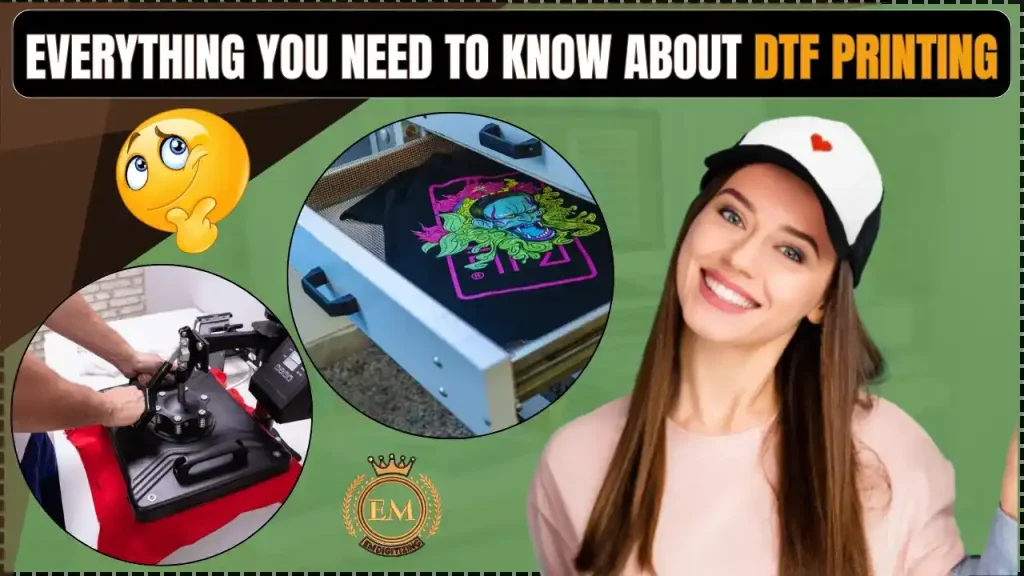
Ce procédé est particulièrement apprécié pour sa flexibilité, car il ne nécessite aucun prétraitement du tissu, ce qui le rend adapté à un large éventail d'applications.
Tout ce que vous devez savoir sur l'impression DTF
Comprendre l'impression DTF
La technologie directe sur film est une méthode d'impression dans laquelle les images numériques sont d'abord imprimées sur un film spécial avant d'être transférées sur du tissu.. Cette approche permet une reproduction de couleurs vives et haute résolution sur une variété de matériaux textiles..
Comment ça marche
- Impression sur film: Les dessins sont imprimés numériquement sur un papier transparent, film spécialisé utilisant des encres spécifiques conçues pour une adhérence et une durabilité optimales.
- Application d'encre: L'encre utilisée est formulée pour créer des, des images vives qui adhèrent bien au film et au tissu.
- Préparation du film: Une fois imprimé, le film subit un processus de préparation au cours duquel un adhésif en poudre est appliqué. Cet adhésif est essentiel pour fixer l'impression sur le tissu.
- Transfert sur tissu: La dernière étape consiste à transférer l'encre du film vers le tissu par chaleur et pression., qui active l'adhésif et garantit que le motif adhère fermement au matériau.
Avantages et inconvénients de l'impression directe sur film
Il offre un mélange de capacités d'impression de haute qualité et de polyvalence, ce qui en fait un choix privilégié pour la personnalisation textile. Cependant, il comporte son propre ensemble de défis qui peuvent avoir un impact sur son efficacité et sa durabilité globales.
Explorons les avantages et les limites de cette méthode d'impression innovante.
Avantages:
- Polyvalence: L'impression par transfert DTF peut être appliquée à une large gamme de tissus, y compris les mélanges synthétiques et les matières délicates, sans nécessiter de prétraitement.
- Qualité: La possibilité d'imprimer du DTF permet une haute résolution, des motifs colorés qui résistent à la décoloration et aux fissures, même après plusieurs lavages.
- Rentable: Idéal pour les lots petits à moyens, réduisant les coûts d'installation et les déchets par rapport aux méthodes d'impression textile traditionnelles.
- Personnalisation: Cette technologie prend en charge une personnalisation étendue, ce qui le rend parfait pour la mode sur mesure et les articles promotionnels uniques.
Désavantages:
- Coûts initiaux: Bien que l'impression DTF réduise les coûts opérationnels continus, l'investissement initial en équipements et matériaux spécialisés peut être élevé.
- Complexité: La gestion du processus d'impression nécessite des connaissances et des compétences techniques, en particulier dans l'ajustement des paramètres de l'imprimante et la manipulation des matériaux.
- Impact environnemental: L'utilisation de films plastiques et d'adhésifs synthétiques pose des problèmes de durabilité, l'élimination des déchets étant un problème important.
- À forte intensité de main d'œuvre: Le processus en plusieurs étapes, de l'impression au transfert thermique, exige plus de travail manuel par rapport aux méthodes d’impression directe sur textile.
Outils et matériaux nécessaires pour une impression DTF efficace
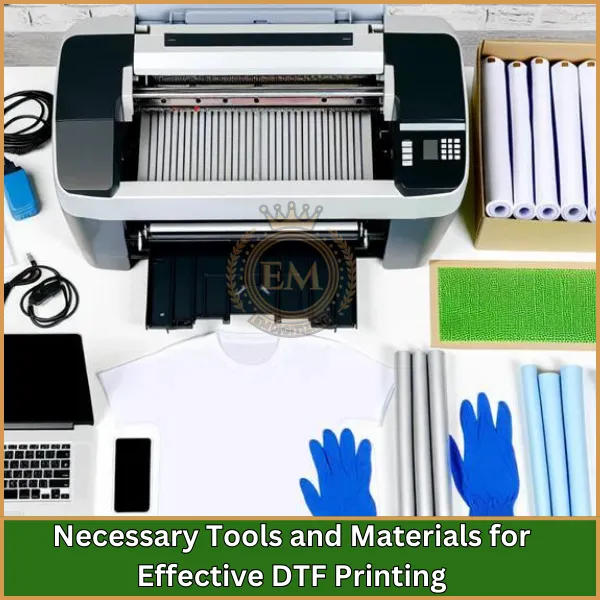
- Machine d'impression DTF: Une imprimante spécialisée capable de répondre aux exigences uniques de l’impression de films.
- Film imprimable: Feuilles de film spéciales conçues pour le transfert de motifs imprimés sur des textiles.
- Chemise DTF: Chemises pré-préparées optimisées pour recevoir des dessins transférés sur film.
- Encres DTF: Encres spécialement formulées qui adhèrent à la fois au film et au tissu.
- Adhésif en poudre: Un composant crucial qui garantit que le motif adhère fermement au tissu après le pressage à chaud.
- Presse chauffée: Équipement utilisé pour appliquer de la chaleur et de la pression pour transférer le motif du film à la chemise.
7. Machine à secouer: Utilisé pour répartir et durcir uniformément l'adhésif en poudre sur le film imprimé.
8. Four de durcissement: Facultatif mais bénéfique pour fixer l'encre de manière permanente sur le tissu après le transfert.
Le processus d'impression DTF étape par étape
Let’;Décomposez le processus de transfert de votre motif sur le tissu à l'aide de la technologie directe sur film., pas à pas.
Marcher 1: Création de conception
Commencez par créer votre graphique à l'aide d'un logiciel de conception adapté aux travaux d'impression..
Marcher 2: Impression sur film
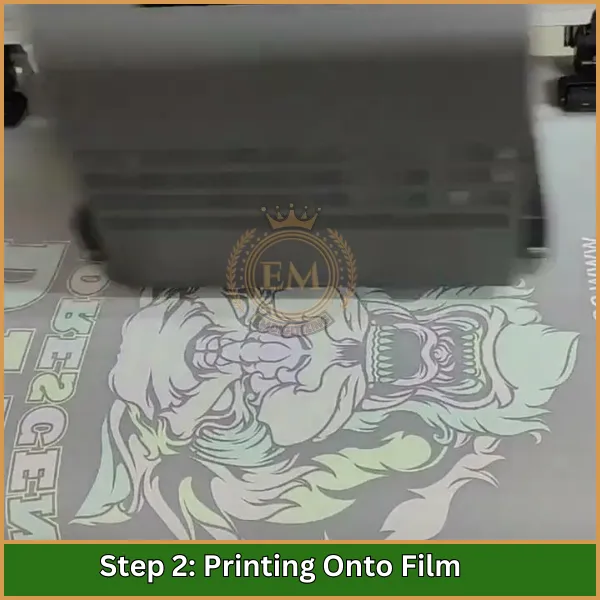
Chargez le film dans un espace dédié Imprimante DTF et appliquez votre design directement sur ce support spécial.
Marcher 3: Application de la poudre adhésive
Appliquez généreusement un adhésif en poudre sur le motif fraîchement imprimé; cela garantit qu'il se liera solidement au tissu plus tard.
Marcher 4: Guérir l'impression
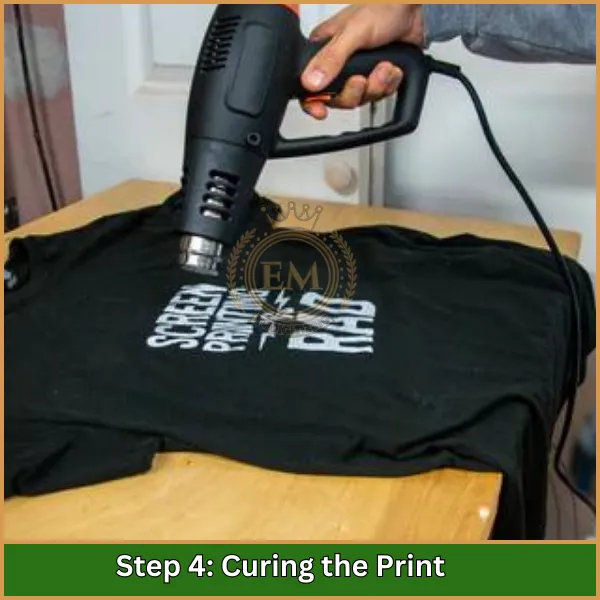
Faites cuire le film dans un four de durcissement ou utilisez une lampe chauffante pour sécher la poudre adhésive sur le motif., le préparer pour le transfert.
Marcher 5: Transfert vers le tissu
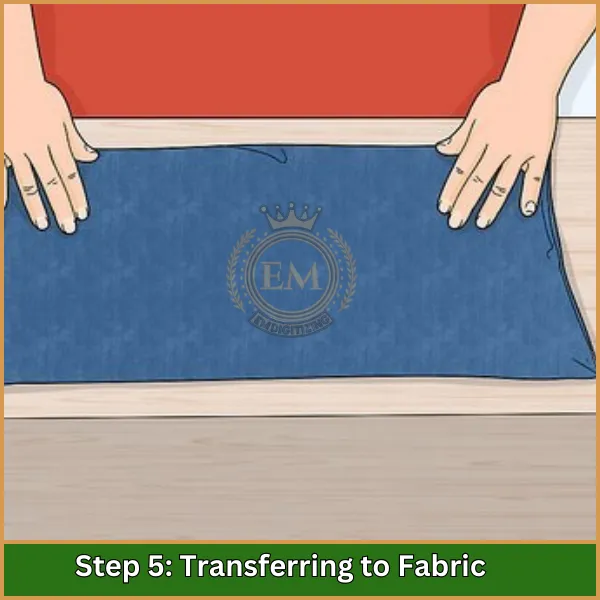
Utilisez une presse à chaud pour appliquer le film sur votre tissu. La chaleur active l'adhésif, coller le design de manière permanente au matériau.
Marcher 6: Décoller le film
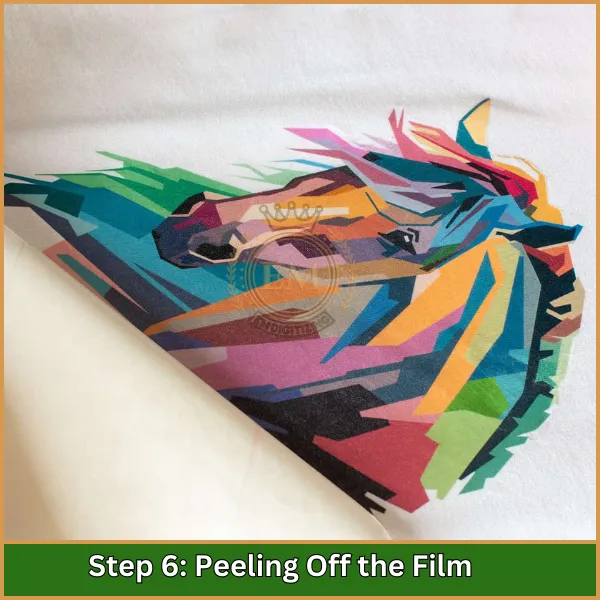
Marcher 6: Décoller le film
Après avoir légèrement refroidi, retirez soigneusement le film du tissu, laissant le dessin intact sur la surface.
Marcher 7: Réglage final de la chaleur
En option, vous devrez peut-être donner une dernière pression au tissu sous une lampe chauffante ou à travers un tunnel pour fixer complètement le motif dans le tissu., améliorant sa durabilité et sa lavabilité.
Dépannage des problèmes courants liés à l'impression DTF
Voici un guide pratique pour résoudre rapidement les problèmes courants auxquels vous pourriez être confronté lors de l'utilisation de la méthode d'impression directe sur film., garantir que vos projets se révèlent parfaits à chaque fois.
Problème: L'encre ne colle pas au film
- Ce qui se produit: L'encre n'adhère pas correctement au film.
- Solution rapide: Assurez-vous que le film est conçu pour une utilisation DTF et vérifiez les paramètres de votre imprimante pour une adhérence optimale de l'encre..
Problème: Impressions floues ou décolorées
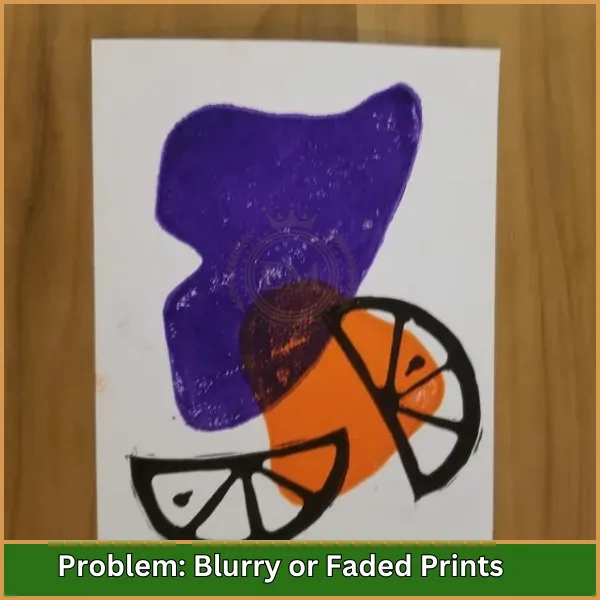
- Ce qui se produit: La qualité d'impression est compromise, semblant flou ou délavé.
- Solution rapide: Utilisez des conceptions haute résolution, vérifier l'approvisionnement en encre adéquat, et nettoyez les buses de l'imprimante pour éviter les blocages.
Problème: Problèmes de poudre adhésive
- Ce qui se produit: La poudre ne colle pas ou ne s’active pas pendant le transfert de chaleur.
- Solution rapide: Appliquez la poudre pendant que l'encre est humide et assurez-vous qu'elle est uniformément répartie avec un shaker..
Problème: Sortie couleur incohérente
- Ce qui se produit: Les couleurs sur le tissu sont différentes du fichier de conception.
- Solution rapide: Calibrez régulièrement votre imprimante et utilisez-la de manière cohérente., encres de haute qualité.
Problème: Pelage du film pendant le transfert
- Ce qui se produit: Le film se détache trop tôt du tissu lors du pressage à chaud.
- Solution rapide: Ajustez les paramètres de votre presse à chaud à la température et à la pression appropriées pour les matériaux spécifiques avec lesquels vous travaillez.
Problème: Adhésif résiduel sur le tissu
- Ce qui se produit: Il y a des résidus collants autour du motif, affectant la sensation et le confort du tissu.
- Solution rapide: Utilisez moins de poudre adhésive et assurez-vous qu'elle est complètement durcie avant de presser pour éviter une adhérence excessive au tissu.
Comparaison de l'impression par transfert DTF avec d'autres méthodes d'impression
Il est devenu un choix de premier plan pour sa polyvalence et sa qualité., mais comment se compare-t-il aux autres techniques d'impression?
Comparons-le avec deux méthodes courantes: DTG (Directement sur le vêtement) impression et traditionnel impression d'écran.
DTF contre. Impression DTG
- Méthode: DTF transfère les dessins du film; DTG imprime directement sur le tissu.
- Compatibilité des tissus: DTF fonctionne sur de nombreux tissus, DTG meilleur sur le coton.
- Éclat des couleurs: Les deux offrent des couleurs vibrantes; Le DTF a une texture légèrement surélevée.
- Rentabilité: Le DTF est meilleur pour les petites et moyennes séries.
- Vitesse: DTF est généralement plus rapide dans la configuration et l'impression de plusieurs éléments.
DTF contre. Impression d'écran
- Méthode: DTF utilise le transfert de chaleur; la sérigraphie utilise de l'encre à travers les écrans.
- Compatibilité des tissus: La sérigraphie excelle sur plus de tissus, y compris les matériaux lourds.
- Éclat des couleurs: La sérigraphie est très vibrante avec une finition plus texturée.
- Rentabilité: La sérigraphie est plus économique pour les grosses commandes.
- Vitesse: La sérigraphie est plus rapide pour les gros lots après la configuration.
Conclusion
L'impression DTF est un excellent moyen de mettre des motifs sur des vêtements et d'autres articles.. Il fonctionne bien avec de nombreux types de tissus et permet de réaliser rapidement et facilement des lots petits à moyens.. DTF facilite la création de conceptions personnalisées chaque fois que vous en avez besoin.
Pour rendre vos projets DTF encore meilleurs, essayez d'utiliser un professionnel services d'art vectoriel. À EMnumérisation, nous offrons de la haute qualité, conceptions détaillées parfaites pour l'impression DTF. Nos designs contribuent à garantir que chaque impression soit claire et colorée..
Tout de suite, nous offrons un 50% remise aux nouveaux clients. Démarrez votre impression DTF avec EMdigitizing et transformez vos idées en magnifiques impressions que tout le monde remarquera. Let us help you make designs that really grab people’;attention.
FAQ
Oui, L'impression DTF est durable et résiste à de nombreux lavages sans se décolorer ni se décoller., ce qui en fait une option fiable pour l'impression sur tissu.
Ça dépend. DTF fonctionne sur plus de tissus, y compris le coton, tandis que la sublimation est la meilleure pour le polyester et offre une douceur, finition semblable à une teinture.
Les principaux inconvénients sont le coût initial élevé et les dépenses permanentes liées aux encres et films spécialisés., de plus, le processus peut être complexe pour les débutants.
Pour les petites et moyennes commandes, DTF est plus rentable en raison de coûts d'installation inférieurs. Pour les gros volumes, la sérigraphie peut être moins chère.
Les impressions DTG peuvent s'estomper avec des lavages fréquents, mais des soins appropriés peuvent les garder dynamiques pendant longtemps.
